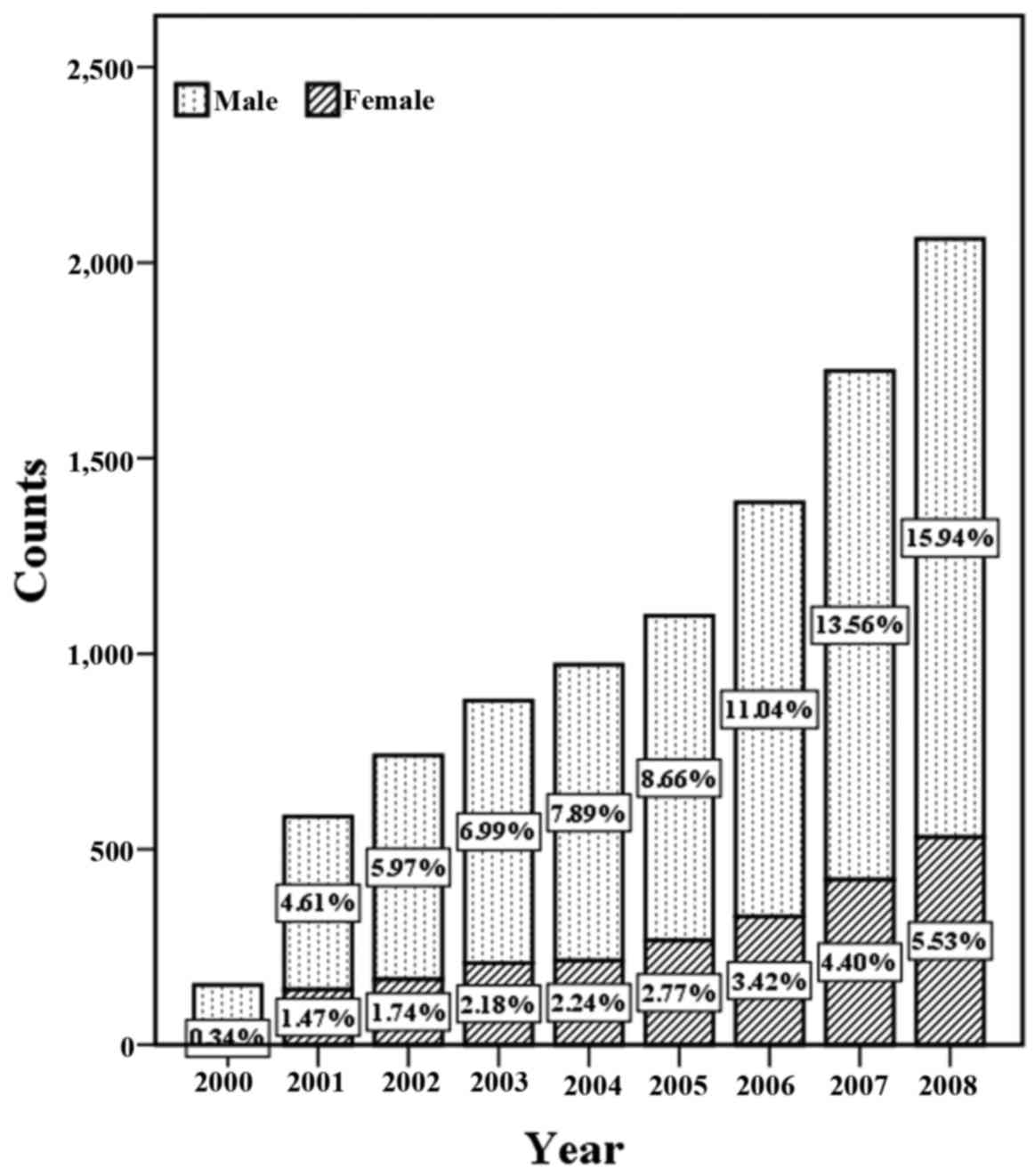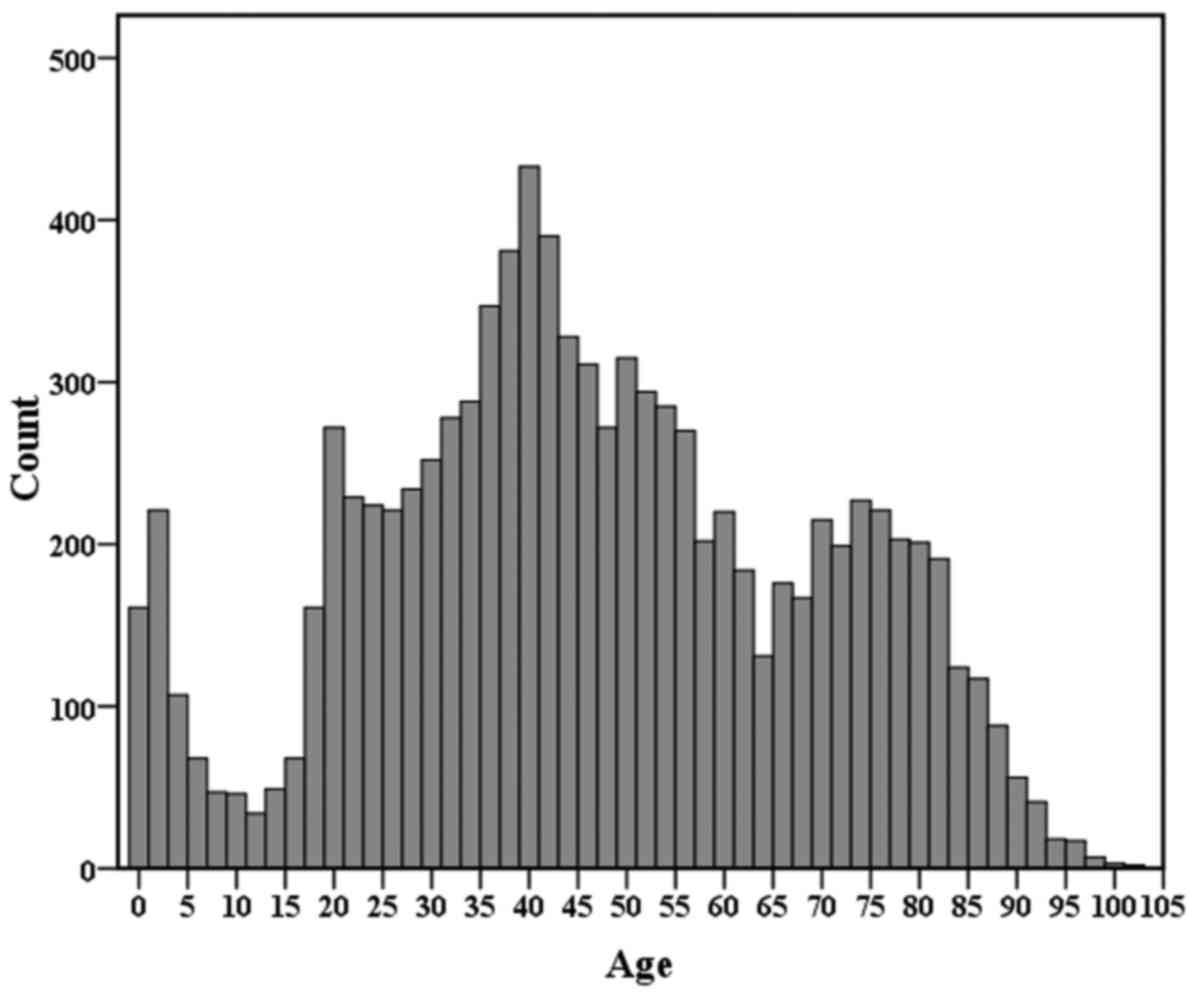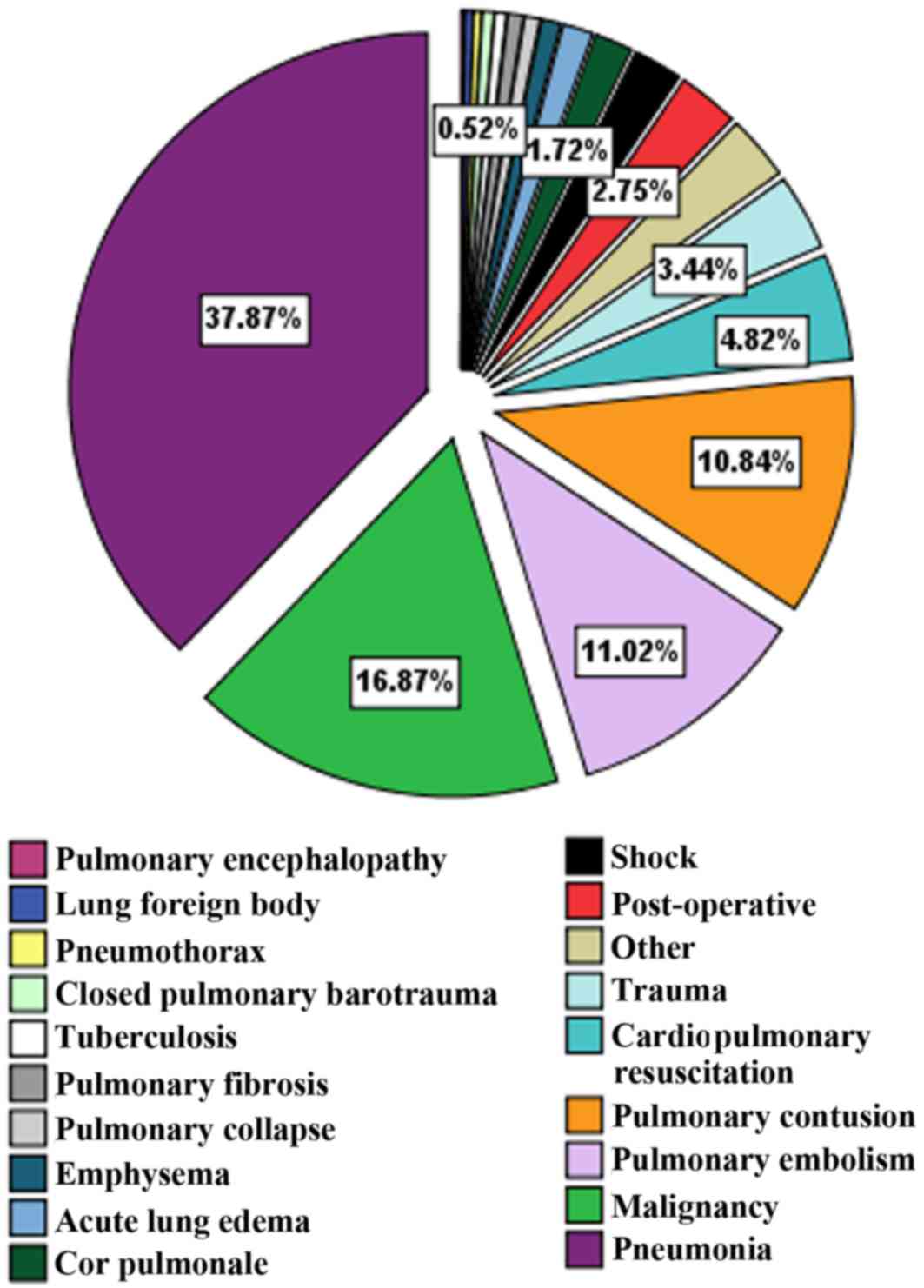Epidemiological analysis of 9,596 patients with acute lung injury at Chinese Military Hospitals
- Authors:
- Published online on: January 20, 2017 https://doi.org/10.3892/etm.2017.4068
- Pages: 983-988
Abstract
Introduction
Acute lung injury (ALI), which is a common and severe syndrome that has been associated with various types of lung diseases, is characterized by a low lung compliance, widespread capillary leakage, a low blood oxygen level (hypoxemia), the development of non-cardiogenic pulmonary edema, progressive respiratory failure and a requirement for mechanical ventilation (1,2). In various studies, the mortality rate of ALI has been reported to be considerably high, at ~40% (3–6).
The etiology and incidence of ALI have not yet been well characterized (7). Previous studies have demonstrated that ALI is caused by local or systemic inflammation triggered by any event, such as local or systemic inflammation, for example malignancies (8,9). Furthermore, the incidence of ALI was reported to be 1.5–100 cases per 100,000 people per year (4,8,9). In order to improve the outcome of ALI, a good understanding of its underlying epidemiology is required. At present, there are no comprehensive data available regarding its epidemiology in China.
In line with the requirements of all level military hospitals, the Information Center of the Medical Department under the Ministry of General Logistics of the Chinese People's Liberation Army (PLA) has designed and developed a standardized comprehensive hospital information system, named the ‘No. 1 Military Medical Project’. This information system comprises three main functional modules that cover the major management functions of a hospital and key clinical procedures, including management of the patient information, medical economic issues and medical materials. Since their launch in September 1995, the general hospitals of the Chinese PLA, including 200 military hospitals and >100 civil hospitals, have applied the ‘No. 1 Military Medical Project’ information system. The included hospitals regularly submit information from this system to the Information Center of the Medical Department, Ministry of General Logistics of the PLA. In the present study, this system provided comprehensive information for ALI patients at all the included hospitals, such that an analysis of the epidemiology of ALI could be implemented.
The aim of the present study was to establish the frequency, etiologies and mortality rates of patients with ALI admitted to the Chinese Military Hospitals between January 2000 and December 2008. The results of the present study may provide guidance for the development of prevention and therapeutic strategies for ALI.
Materials and methods
Data collection
Data used in the present study were directly derived from the ‘No. 1 Military Medical Project’ information system and corresponded to between January 2000 and December 2008. A retrospective analysis of all ALI inpatients at 10 Chinese Military Hospitals was conducted. Hospital admission ALI data were extracted, and inpatients and outpatients not diagnosed with ALI as the primary disease were excluded from the present study. Data regarding gender, age, time distribution, predisposing conditions and outcome were reviewed. The present study was approved by the Institutional Review Board of Daping Hospital (Third Military Medical University, Chongqing, China), and patient records/information were anonymized and de-identified prior to analysis.
Statistical analysis
All analyses were performed using SPSS version 17.0 software (SPSS Inc., Chicago, IL, USA). Categorical variables were analyzed using χ2 tests. The χ2 value may have been overrepresented due to the large sample size, since the value is based on the strength of an association and the size of a sample. In order to modify the easily achieved statistical value, the contingency coefficient was introduced as a valuable statistic. Quantitative variables with a skewed distribution were presented as the median and interquartile range (IQR). P<0.05 was considered to indicate a statistically significant difference.
Results
Demographic data
As shown in Table I, a total of 9,596 patients with ALI were admitted to the Chinese Military Hospitals between January 2000 and December 2008. Among the patients, 7,284 (75.91%) were male and 2,312 (24.09%) were female (Table I). The median age for all patients was 44 years (IQR, 31–63 years). The median age in males was 42 years (IQR, 30–57 years), while in females it was 55 years (IQR, 36–73 years). A significant difference in median age was detected (P<0.001).
Time distribution
The number of patients with ALI admitted to the Chinese Military Hospitals exhibited an increasing trend over time, as shown in Fig. 1. There was no significant difference in the gender distribution of ALI incidence among the years of admission (P=0.529, c=0.027; Table I). Conversely, there was a significant difference in the gender distribution among the months of admission (P=0.014, c= 0.050; Table I). As shown in Fig. 2, the incidence of ALI was more prevalent in May, July, August, October, November and December, as compared with the other months of the year (Fig. 2).
Age distribution
The age distribution of the total ALI admissions between 2000 and 2008 is shown in Fig. 3. Patients admitted to the Chinese Military Hospitals with ALI were aged between 1 and 101 years. The peak proportion was observed at ~40 years of age.
Predisposing conditions and risk factors for ALI development
Among the 9,596 hospital admission cases with available details on predisposing conditions or risk factors, the majority of cases presented pulmonary contusion (45.71%), followed by pneumonia or respiratory tract infections (23.68%) and pulmonary malignant tumors (6.30%), as shown in Table II.
Table II.Predisposing conditions and clinical risk factors for 9,596 patients, including 581 deceased patients, with acute lung injury. |
Outcome and mortality
Among the 9,596 patients admitted to the Chinese Military Hospitals between 2000 and 2008, 5,446 (56.75%) were reported as fully recovered, 3,108 (32.39%) were reported as improved, 114 (1.19%) were deemed invalid, 139 (1.45%) were untreated and 581 (6.05%) were reported as mortalities (Table III).
In the 581 mortality cases, pneumonia constituted the most common cause (37.87%), followed by malignancies (16.87%) and pulmonary embolism (11.02%), as shown in Fig. 4. In addition, Table II shows the proportions of deceased patients with particular predisposing conditions or clinical risk factors, and their associated mortality rates.
Discussion
Accurate epidemiological data are essential to provide pilot data and to assess the feasibility of performing clinical trials (10). The results of the present study may provide important information for clinicians and health regulators worldwide regarding the prevention and treatment of ALI.
The incidence of ALI is a key point in epidemiology and is important for its diagnosis and management (7). However, due to the unclear population size, the present study was unable to calculate the incidence of ALI.
ALI is a common disease among critically ill patients, in whom it has a marked effect on morbidity and mortality. Several issues concerning the epidemiology of ALI require improvement, such as patient characteristics, presentation and mortality. The present study aimed to investigate the epidemiology of ALI in 9,596 patients admitted to Chinese Military Hospitals between 2000 and 2008. Notably, the incidence of ALI was found to be higher in males, as compared with females. We speculated that gender-based differences existed at clinical presentation prior to ALI. Furthermore, the median age of male patients was 44 years, whereas the median age of female patients was 55 years. ALI occurred among all ages, although the peak incidence was at ~40 years.
The current study demonstrated that ALI-associated admissions to the Chinese Military Hospitals showed an increasing trend between 2000 and 2008. The underlying reason for this was unclear, although it may suggest that ALI should be increasingly monitored in the future. In addition, ALI admissions were more prevalent in May, July, August, October, November and December, as compared with the other months, which may be due to the predisposing conditions of ALI. Further studies are required to analyze these predisposing conditions of ALI.
Various risk factors associated with ALI, such as severe pulmonary dysfunction, neoadjuvant chemotherapy, and chronic alcohol consumption, have been reported in previous studies (11–17). The present study analyzed the predisposing conditions of 9,596 patients with ALI, including pulmonary encephalopathy, pulmonary cyst, shock, cardiopulmonary resuscitation, pneumonia and trauma. It was demonstrated that pulmonary contusion was the most common predisposing condition for ALI, followed by pneumonia or respiratory tract infections, and then pulmonary malignant tumors. These results suggested that the incidence of ALI may vary greatly depending on the predisposing condition. Although the association of predisposing conditions with the severity of ALI remains debated, the existence of a predisposing condition was regarded as one of the most important features based on incidence.
The present study demonstrated that the crude mortality rate of all hospitalized patients with ALI was 6.05%. The morbidity and mortality rates of ALI have previously been associated with its predisposing conditions (15). Furthermore, a previous study reported that the mortality rate of ALI is evidently high (6). In the present study, cardiopulmonary resuscitation was associated with the highest mortality rate (48.28%) among all the predisposing conditions and clinical risk factors. Although the highest proportion of mortalities for that period were attributed to pneumonia, the mortality rate for patients with pneumonia and ALI was only 9.68%. These results suggested that the mortality rate of ALI is predominantly associated with the underlying disease, including the degree of organ dysfunction and the severity. However, treatment of ALI should focus on efficiently dealing with the predisposing conditions.
In conclusion, the findings of the present study demonstrated an increased trend in ALI admission with a majority of middle-aged patients. The majority of ALI cases presented with pulmonary contusion. The average mortality rate for ALI was 6.05% and the major causes of death were pneumonia followed by malignancies. The results of the present study provided novel information regarding the epidemiology of ALI, and offer potential insight into future areas for improving the clinical care and investigation of ALI.
Acknowledgements
The authors of the present study would like to thank the patients who participated in the study, and the laboratory technicians for their valuable efforts.
References
|
Definition Task Force ARDS. Ranieri VM, Rubenfeld GD, Thompson BT, Ferguson ND, Caldwell E, Fan E, Camporota L and Slutsky AS: Acute respiratory distress syndrome: The Berlin Definition. JAMA. 307:2526–2533. 2012.PubMed/NCBI | |
|
Bernard GR, Artigas A, Brigham KL, Carlet J, Falke K, Hudson L, Lamy M, Legall JR, Morris A and Spragg R: The American-European consensus conference on ARDS. Definitions, mechanisms, relevant outcomes, and clinical trial coordination. Am J Respir Crit Care Med. 149:818–824. 1994. View Article : Google Scholar : PubMed/NCBI | |
|
Vasilyev S, Schaap RN and Mortensen JD: Hospital survival rates of patients with acute respiratory failure in modern respiratory intensive care units. An international, multicenter, prospective survey. Chest. 107:1083–1088. 1995. View Article : Google Scholar : PubMed/NCBI | |
|
Lewandowski K, Metz J, Deutschmann C, Preiss H, Kuhlen R, Artigas A and Falke KJ: Incidence, severity and mortality of acute respiratory failure in Berlin, Germany. Am J Respir Crit Care Med. 151:1121–1125. 1995. View Article : Google Scholar : PubMed/NCBI | |
|
Phua J, Badia JR, Adhikari NK, Friedrich JO, Fowler RA, Singh JM, Scales DC, Stather DR, Li A, Jones A, et al: Has mortality from acute respiratory distress syndrome decreased over time?: A systematic review. Am J Respir Crit Care Med. 179:220–227. 2009. View Article : Google Scholar : PubMed/NCBI | |
|
Luhr OR, Antonsen K, Karlsson M, Aardal S, Thorsteinsson A, Frostell CG and Bonde J: Incidence and mortality after acute respiratory failure and acute respiratory distress syndrome in Sweden, Denmark and Iceland. The ARF Study Group. Am J Respir Crit Care Med. 159:1849–1861. 1999. View Article : Google Scholar : PubMed/NCBI | |
|
Frutos-Vivar F, Nin N and Esteban A: Epidemiology of acute lung injury and acute respiratory distress syndrome. Curr Opin Crit Care. 10:1–6. 2004. View Article : Google Scholar : PubMed/NCBI | |
|
Webster NR, Cohen AT and Nunn JF: Adult respiratory distress syndrome-how many cases in the UK? Anaesthesia. 43:923–926. 1988. View Article : Google Scholar : PubMed/NCBI | |
|
Fowler AA, Hamman RF, Good JT, Benson KN, Baird M, Eberle DJ, Petty TL and Hyers TM: Adult respiratory distress syndrome: Risk with common predispositions. Ann Intern Med. 98:593–597. 1983. View Article : Google Scholar : PubMed/NCBI | |
|
Irish Critical Care Trials Group, . Acute lung injury and the acute respiratory distress syndrome in Ireland: A prospective audit of epidemiology and management. Crit Care. 12:R302008. View Article : Google Scholar : PubMed/NCBI | |
|
Roupie E, Lepage E, Wysocki M, Fagon JY, Chastre J, Dreyfuss D, Mentec H, Carlet J, Brun-Buisson C, Lemaire F and Brochard L: Prevalence, etiologies and outcome of the acute respiratory distress syndrome among hypoxemic ventilated patients. SRLF collaborative group on mechanical ventilation. Société de Réanimation de Langue Française. Intensive Care Med. 25:920–929. 1999. View Article : Google Scholar : PubMed/NCBI | |
|
Suchyta MR, Clemmer TP, Elliott CG, Orme JF Jr and Weaver LK: The adult respiratory distress syndrome. A report of survival and modifying factors. Chest. 101:1074–1079. 1992. View Article : Google Scholar : PubMed/NCBI | |
|
Monchi M, Bellenfant F, Cariou A, Joly LM, Thebert D, Laurent I, Dhainaut JF and Brunet F: Early predictive factors of survival in the acute respiratory distress syndrome. A multivariate analysis. Am J Respir Crit Care Med. 158:1076–1081. 1998. View Article : Google Scholar : PubMed/NCBI | |
|
Doyle RL, Szaflarski N, Modin GW, Wiener-Kronish JP and Matthay MA: Identification of patients with acute lung injury. Predictors of mortality. Am J Respir Crit Care Med. 152:1818–1824. 1995. View Article : Google Scholar : PubMed/NCBI | |
|
Eisner MD, Thompson T, Hudson LD, Luce JM, Hayden D, Schoenfeld D and Matthay MA: Acute Respiratory Distress Syndrome Network: Efficacy of low tidal volume ventilation in patients with different clinical risk factors for acute lung injury and the acute respiratory distress syndrome. Am J Respir Crit Care Med. 164:231–236. 2001. View Article : Google Scholar : PubMed/NCBI | |
|
Page B, Vieillard-Baron A, Beauchet A, Aegerter P, Prin S and Jardin F: Low stretch ventilation strategy in acute respiratory distress syndrome: Eight years of clinical experience in a single center. Crit Care Med. 31:765–769. 2003. View Article : Google Scholar : PubMed/NCBI | |
|
Esteban A, Anzueto A, Frutos F, Alía I, Brochard L, Stewart TE, Benito S, Epstein SK, Apezteguía C, Nightingale P, et al: Characteristics and outcomes in adult patients receiving mechanical ventilation: A 28-day international study. JAMA. 287:345–355. 2002. View Article : Google Scholar : PubMed/NCBI |













